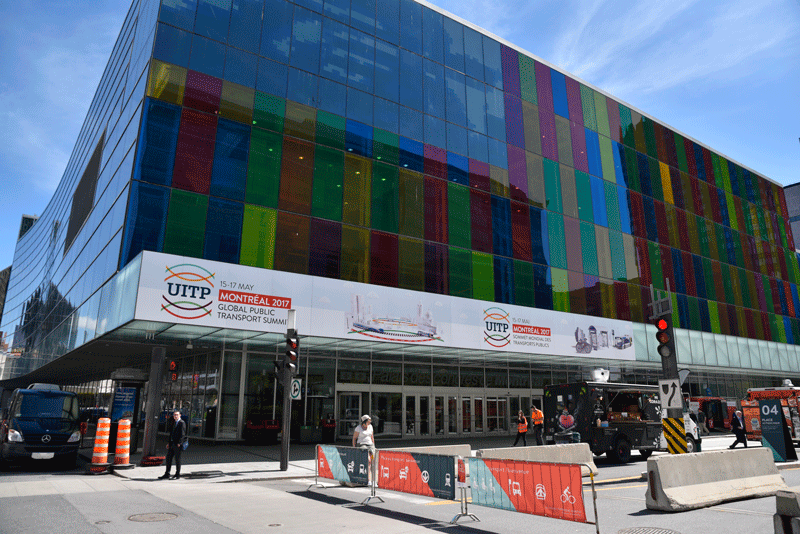Summit Dispatches, Day 2: Autonomous Vehicles, Data Trailblazers, and Innovation in Urban Transport
Good morning and welcome back to the world’s largest public transport event. I’m up at the crack of dawn, too excited to sleep at the prospect of testing fully autonomous and electric vehicles (jet lag also probably had something to do with this). Today is North American Day at the Summit, and what a day for it: despite the forecast of heavy rain, the sun is out in all its glory. To celebrate the North American achievements in urban mobility, the Palais is full of performers and there is certain air of festivity –
Québécois musicians welcome delegates in the lobby, flannelled jugglers and stilt-walkers wander the exhibition space, cakes and treats can be found throughout the sessions. It’s going to be a good day…
9:00–10:00, Autonomous vehicle test ride
I’m first in line for the autonomous vehicle (AV) test ride. There are two different shuttles demoing today: a cherry-red AV from Transdev and Easymile, and a sleek white shuttle from Keolis and Navya. I’m already wearing my ‘I Love AVs’ badge from a session yesterday, and ready for my first experience with driverless technology.
The Easymile EZ10 can transport up to 12 people, with a max speed of 40km/h (though an operating speed of 20km/h). It runs on a route that is mapped beforehand with cameras and radar, and, it goes without saying, is 100% electric. The shuttle looks vaguely Pixar-y, like something out of Wall-E, and the first descriptor that comes to mind is a word I wouldn’t normally associate with a vehicle… cute.
I step onto the shuttle, with the same mix of trepidation and excitement that Neil Armstrong must have felt in 1969: one small step for man, one giant leap for urban mobility. The doors shut and we’re off, smoothly following the pre-determined path, and I feel strangely serene as we glide forward, my view through the windscreen unimpeded by a driver.
I think about the future of transport, the fact that AVs will almost certainly fill public roads in my lifetime. While the sharp right-angle corners proved difficult for the shuttle to turn, slowing it to a crawling pace, there were no hiccups in the journey.
After disembarking, I immediately line up for the Navya test, and find the ride to be more or less the same. The vehicle is slightly faster, with an interactive touch screen providing on-demand navigation, though I have to admit I prefer the red finish of the Transdev shuttle.
11:00–12:30, “Transport aggregators and their role in cities”
Following my AV experience, I’m eager to discover the innovators at the forefront of the data revolution in transport. Chairperson Melissa Whitehead, Commissioner of Cape Town’s Transport and Urban Development Authority, claimed that this session featured the youngest speakers. The panel included Devin de Vries, Co-Founder of WhereIsMyTransport; Mohamed Hegazy, Director of Transport for Cairo; and Jake Sion, Chief Operating Officer of Montréal’s own Transit App.
All speakers shared the same ethos: information is power, and data is the backbone of an innovative mobility system. “I believe in information over infrastructure”, said Mr de Vries. “Operators should worry less about improving or adding to current infrastructure, and more about optimising transport data.”
He continued by outlining the remarkable contribution that WhereIsMyTransport has made to emerging cities around the world: bridging the divide between formal and informally-run transport. For instance, in South Africa, informally-run transport makes up two-thirds of the public transport system; in neighbouring Botswana, 100% of transport is informal. The problem with informal transport is that there is no official data, thus making it impossible for transport operators to include this information in decision-making and public policy.
WhereIsMyTransport offers a platform for integrated transport data, aggregating all of the information and making it available to cities and the private sector to ultimately make public transport more accessible. “Accessible public transport unlocks the potential of people and cities. It is key to an inclusive, sustainable society”, concluded de Vries.
Both Mohamed Hegazy and Jake Sion discussed the importance of data collection and aggregation. “Information is the solution to most transport problems”, said Mr Hegazy. “Transport data is necessary to measure indicators, like SDG 11.2 [access to sustainable transport] to see if we are improving and moving in the right direction.”
Sion’s Transit App offers multi-modal navigation functionality, including formal and informal transport; it relies entirely on data from transport authorities. “Transit agencies are often lambasted for being bureaucratic and slow, but most agencies around the world have shared open-source data with apps like ours. Transit agencies are to thank for this innovation”, said Sion. [Click here for more information about the General Transit Feed Specification (GTFS), which is what all navigation apps run on and is essentially the backbone of the transport data revolution].
Throughout the session I had the feeling of being at the frontier of this new field in the sector; witnessing true trailblazers mapping routes and opening cities up to the world. I left the room with Sion’s words echoing in my head: “Data is the foundation for everything that is to come in urban transport.”
16:00–17:30, “Plenary Session: Enabling innovation for greater urban transport”
In the final session of the day, the audience gathered to hear the panellists speak on the key theme of the entire Summit: innovation. UITP Secretary General, Alain Flausch, kicked off the session by presenting the initial findings of UMii, the Urban Mobility Innovation Index.
The index provides insights into urban mobility and innovation in cities across the world, offering a guide for cities to foster innovation in their transport systems. The key messages of UMii included the importance of sharing data and strategy, and of approaching mobility in the wider context of sustainable urban planning. “Innovation must be data-driven and user-centred”, said Mr Flausch.
Ed Reiskin, Director of Transportation at San Francisco Municipal Transportation Agency, agreed that data is key to innovation, but specified that it must remain open and public. “We believe in open data. It is all public information, and I think there is an obligation to share it”, said Mr Reiskin.
Following suit, Bernt Reitan Jenssen, CEO of Oslo transport authority Ruter, urged that, “Data is the strategic core of our business. But it is our customer’s data, not ours. We are like a bank, protecting the data for our customers, using it to provide them freedom and access”.
The key takeaway of the session was that in these rapidly changing times, the old model of public transport no longer applies. “We cannot rely on our old business model of taking people from where they are not, to where they don’t want to go. The new model must take people from where they are to where they want to go. If we don’t change, we run the risk of being extinct, or at least irrelevant”, said Mr Jenssen.


